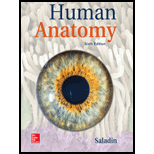
The function of the pectoral girdle; the bones that compose it; and all points at which these bones articulate with each other, with the upper limb, and with the axial skeleton
To determine:
The function of the pectoral girdle; the bones that compose pectoral girdle; all points at which bones composing pectoral girdle articulate with each other, upper limb, and with axial skeleton.
Introduction:
The appendicular system is the skeleton system that is composed of the bones of upper limbs, lower limbs, pelvic girdle, and the pectoral girdle. The bones of the appendicular skeleton are categorized based upon six regions. Pectoral girdle contains four bones, arms and forearm possess six bones, clavicle, scapula, humerus, ulna, and radius contain two bones.
Explanation of Solution
The bones of upper limbs attach to the axial skeleton and form the pectoral girdle. The pectoral girdle is the flexible bone that makes the shoulder joints easy to dislocate and movement. The axial skeleton allows the extensive mobility to the pectoral girdle and thus to upper limbs and shoulders.
The pectoral girdle along the axis connects with the upper limb. The pectoral girdle (also called shoulder girdle) consists of two types of bones: the clavicle (or collarbone) and scapula bones (or shoulder blade).
Clavicle possesses three parts, the shaft, medial end, and lateral end. The shaft is the body of the clavicle. The medial end of the clavicle is attached to the sternum through the sternoclavicular joint. The lateral end is supported by articulation with scapula through the acromioclavicular joint. The clavicle provides the articulation with the axial skeleton through the medial end.
The scapula is the triangular bone dorsal to the collarbone and is divided into three borders, medial, lateral, and superior. Scapula connects the upper extremity of the upper limb to the trunk. The humerus is the portion of the upper limb that is articulated with scapula through the glenohumeral joint.
Axial skeleton articulates with the pectoral girdle at the trunk and includes the vertebrae, rib, coccyx, sacrum, and sternum. The bones supporting at the left and right region of the shoulder connect the muscles that are necessary for the movement. Scapula and clavicle together as a unit can be felt by palpation.
Want to see more full solutions like this?
Chapter 8 Solutions
Human Anatomy
- In a small summary write down:arrow_forwardNot part of a graded assignment, from a past midtermarrow_forwardNoggin mutation: The mouse, one of the phenotypic consequences of Noggin mutationis mispatterning of the spinal cord, in the posterior region of the mouse embryo, suchthat in the hindlimb region the more ventral fates are lost, and the dorsal Pax3 domain isexpanded. (this experiment is not in the lectures).a. Hypothesis for why: What would be your hypothesis for why the ventral fatesare lost and dorsal fates expanded? Include in your answer the words notochord,BMP, SHH and either (or both of) surface ectoderm or lateral plate mesodermarrow_forward
- Understanding Health Insurance: A Guide to Billin...Health & NutritionISBN:9781337679480Author:GREENPublisher:Cengage
 Medical Terminology for Health Professions, Spira...Health & NutritionISBN:9781305634350Author:Ann Ehrlich, Carol L. Schroeder, Laura Ehrlich, Katrina A. SchroederPublisher:Cengage Learning
Medical Terminology for Health Professions, Spira...Health & NutritionISBN:9781305634350Author:Ann Ehrlich, Carol L. Schroeder, Laura Ehrlich, Katrina A. SchroederPublisher:Cengage Learning Anatomy & PhysiologyBiologyISBN:9781938168130Author:Kelly A. Young, James A. Wise, Peter DeSaix, Dean H. Kruse, Brandon Poe, Eddie Johnson, Jody E. Johnson, Oksana Korol, J. Gordon Betts, Mark WomblePublisher:OpenStax College
Anatomy & PhysiologyBiologyISBN:9781938168130Author:Kelly A. Young, James A. Wise, Peter DeSaix, Dean H. Kruse, Brandon Poe, Eddie Johnson, Jody E. Johnson, Oksana Korol, J. Gordon Betts, Mark WomblePublisher:OpenStax College Human Biology (MindTap Course List)BiologyISBN:9781305112100Author:Cecie Starr, Beverly McMillanPublisher:Cengage Learning
Human Biology (MindTap Course List)BiologyISBN:9781305112100Author:Cecie Starr, Beverly McMillanPublisher:Cengage Learning





